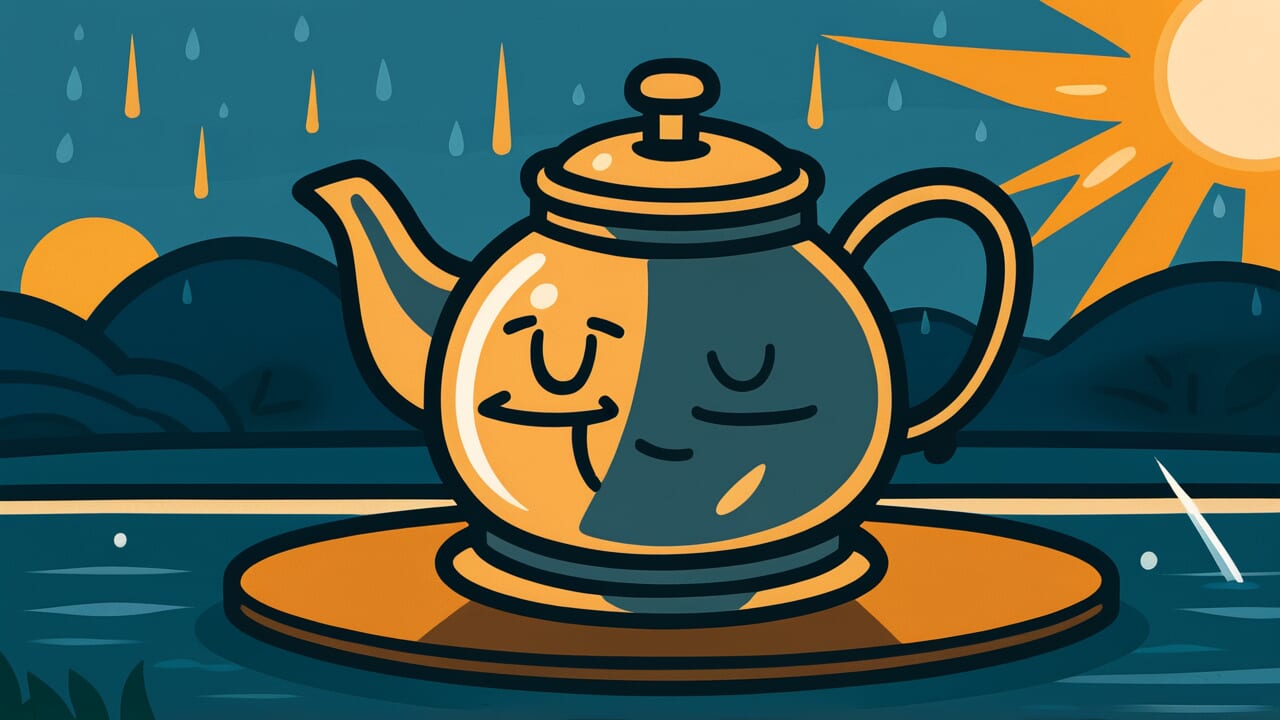How to Read “After the rain, a kettle’s glare”
Ameagari no yakanteri
Meaning of “After the rain, a kettle’s glare”
“After the rain, a kettle’s glare” is a proverb that describes a weather phenomenon. Right after rain stops, intense sunlight suddenly beats down.
This happens especially often in summer. Moisture evaporates from the wet ground. High humidity combines with strong sunlight. The result is an extremely muggy and uncomfortable heat.
People use this expression to describe a unique kind of unpleasant heat. It’s different from ordinary sunny weather. The comparison to a kettle heated on a fire is perfect.
It conveys more than just sunshine. It captures that searing, scorching sensation of intense heat.
People still use this phrase today in weather forecasts and daily conversation. You might hear someone say, “After this rain, we’ll get a kettle’s glare.”
It’s especially useful after the rainy season ends or following summer showers. When temperature and humidity spike suddenly, this expression vividly captures that uncomfortable heat.
Origin and Etymology
The exact first written use of “After the rain, a kettle’s glare” is unclear. However, people likely used it since the Edo period. Common folk passed it down through generations.
The interesting part is the unique expression “kettle’s glare.” A kettle is a metal tool used to boil water. When placed over fire, its bottom turns bright red. Steam rises as it heats up intensely.
This image of a heating kettle perfectly matches the sensation after rain. When rain stops and clouds suddenly break, the sun appears. Water remaining on the ground starts evaporating.
The rising steam combines with strong sunlight. It feels like the entire earth is being heated like a kettle on fire. People compared this physical sensation to an everyday household item.
This shows the practical wisdom of ordinary people. After summer rain especially, humidity and temperature rise sharply together. The result is unpleasant, sticky heat.
To express this unique sensation, people brought up the familiar kettle. They compared it to how a kettle heats up. The phrase “yakanteri” also has a rhythmic sound. It’s easy to say and remember.
This catchiness likely helped the expression spread widely.
Usage Examples
- The morning rain stopped, but now it’s a kettle’s glare after the rain and I can’t stop sweating
- I finally hung out the laundry, but with this kettle’s glare after the rain, it might smell musty from incomplete drying
Universal Wisdom
The proverb “After the rain, a kettle’s glare” reflects nature’s dramatic shifts. It also shows how humans struggle with these changes. Rain falls one moment, then intense sunlight beats down the next.
This rapid change mirrors life itself. Everyone expects relief when difficult situations end. But reality often brings different challenges right after one trial passes.
You feel happy when rain stops, but then the muggy heat torments you. This natural phenomenon perfectly expresses the truth of “out of the frying pan, into the fire.”
Yet people have passed down this proverb not just to lament endless difficulties. Rather, they calmly observed natural changes and put them into words. By sharing these observations, people learned how to prepare mentally for change.
If you know a kettle’s glare follows rain, you can prepare for it.
Our ancestors accepted nature’s laws while thinking about how to live within them. Change is unavoidable. So they developed wisdom to predict, understand, and respond to it.
This proverb contains such practical life philosophy.
When AI Hears This
“After the rain, a kettle’s glare” shows how violently a massive system tries to return to balance. During rain, the atmosphere holds huge amounts of water vapor. Temperature stays suppressed too.
Energy goes into water evaporation and cloud formation. Less heat reaches the ground as a result. Thermodynamically, this is a “high entropy state” where energy disperses into various forms.
But when rain stops, this state collapses suddenly. Sunlight pours onto the ground without obstruction. Water evaporates from wet surfaces and plants. The cooling effect of evaporation ends.
Then water vapor starts condensing and releasing heat instead. The atmosphere rushes back toward equilibrium. The energy flow during this process becomes extremely unidirectional and intense.
Non-equilibrium thermodynamics tells us something important. Systems farther from equilibrium create larger energy flux when returning to balance. “After the rain, a kettle’s glare” perfectly demonstrates this principle through physical sensation.
The heat feels more extreme than on a calm sunny day. This happens because rain creates an extreme state first. The rebound from that extreme state produces abnormal heat.
Nature shows more drama when recovering from extreme states than from moderate changes.
Lessons for Today
This proverb teaches modern people to view changing situations from multiple angles. We often think one problem’s solution means everything will work out. The project ends and we’ll relax.
The exam finishes and we’ll be free. The rain stops and we’ll be comfortable. But reality usually has another challenge waiting after one situation ends.
What matters is preparing mentally to respond flexibly to continuous change. If you know a kettle’s glare follows rain, you can prepare a parasol. You can look for cool places.
Life works the same way. By predicting what comes next and preparing mentally, you can handle things calmly without panic.
This proverb also teaches us not to demand “perfect conditions.” Both rain and heat are parts of nature. Accepting that completely comfortable states don’t exist helps you develop resilience.
You won’t get thrown off by small discomforts. Don’t treat change as an enemy. Instead, live alongside change.
That’s the quiet yet powerful message this proverb offers modern people.



Comments